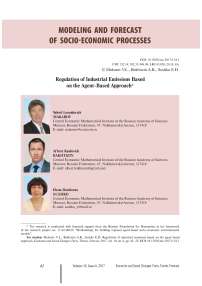Regulation of industrial emissions based on the agent-based approach
Автор: Makarov Valerii Leonidovich, Bakhtizin Albert Raufovich, Sushko Elena Davidovna
Журнал: Economic and Social Changes: Facts, Trends, Forecast @volnc-esc-en
Рубрика: Modeling and forecast of socio-economic processes
Статья в выпуске: 6 (54) т.10, 2017 года.
Бесплатный доступ
The article demonstrates one of the most advanced methods for regulation of industrial emissions, which is used by governments of different countries - an emissions trading system based on the bubble principle. This method is a tool for incentive-based control to encourage businesses to reduce the burden on the environment, providing emissions limits of harmful substances, but at the same time giving them some freedom to choose the methods to achieve the specified emission standards. To create a domestic comprehensive system for emissions regulation it would be useful to use the instruments for preliminary evaluation of effects from the implementation of various control measures. One of such instruments may be the agent-based regional model developed by the authors in the present paper. The model will help test different combinations of control measures - both administrative and market - with the use of computer experiments in order to find a balanced combination. The model simulates production activity of agent enterprises which employ agent people...
Agent-based model, air pollution, market-based instrument, bubble principle, emissions trading, incentive-based control
Короткий адрес: https://sciup.org/147224007
IDR: 147224007 | DOI: 10.15838/esc.2017.6.54.3
Список литературы Regulation of industrial emissions based on the agent-based approach
- Averchenkov A.A., Galenovich A.Yu., Safonov G.V., Fedorov Yu.N. Regulirovanie vybrosov parnikovykh gazov kak faktor povysheniya konkurentosposobnosti Rossii . Moscow: NOPPPU, 2013. 88 p..
- Burkov V.N., D.A. Novikov Teoriya aktivnykh sistem: sostoyanie i perspektivy . Moscow: SINTEG, 1999. 128 p..
- Burkov V.N., Novikov D.A., Shchepkin A.V. Mekhanizmy upravleniya ekologo-ekonomicheskimi sistemami . Ed. by S.N. Vasil'ev. Moscow: Izdatel'stvo fiziko-matematicheskoi literatury, 2008. 244 p..
- Eremenko Yu.I., Doronina E.G. Model' adaptivnogo povedeniya agentov mul'tiagentnoi sistemy upravleniya ekologicheskoi bezopasnost'yu . Prikladnaya informatika , 2010, no. 2(26), pp. 71-82..
- Makarov V.L., Bakhtizin A.R. Sotsial'noe modelirovanie -novyi komp'yuternyi proryv (agent-orientirovannye modeli) . Moscow: Ekonomika, 2013. 295 p..
- Makarov V.L., Bakhtizin A.R., Sushko E.D. Agent-orientirovannaya sotsio-ekologo-ekonomicheskaya model' regiona . Natsional'nye interesy: prioritety i bezopasnost' , 2015, no. 3, pp. 2-11..
- Tarasov V.B. Ot mnogoagentnykh sistem k intellektual'nym organizatsiyam: filosofiya, psikhologiya, informatika . Moscow: Editorial URSS, 2002. 352 p..
- Treiman M.G., Yudin A.P. Primenenie "babl-printsipa" dlya vodnykh ob"ektov na primere akvatorii reki Neva . Nauchnyi zhurnal NIU ITMO. Seriya "Ekonomika i ekologicheskii menedzhment" , 2014, no. 2. Available at: https://cyberleninka.ru/article/n/primenenie-babl-printsipa-dlya-vodnyh-obektov-na-primere-akvatorii-reki-neva..
- Burtraw D. Innovation Under the Tradable Sulfur Dioxide Emission Permits Program in the US Electricity Sector. Discussion Paper 00-38. Washington, D.C.: Resources for the Future, 2000. P. 28. Available at: http://www.rff. org/files/sharepoint/WorkImages/Download/RFF-DP-00-38.pdf.
- Burtraw D., Szambelan S. J. U.S. Emissions Trading Markets for SO2 and NOx. Discussion Paper 09-40. Washington, D.C.: Resources for the Future, 2009. P. 42. Available at: http://www.rff.org/files/sharepoint/WorkImages/Download/RFF-DP-09-40.pdf.
- Chan G., Stowe R., Sweeney R., Stavins R. The SO2 allowance-trading system and the Clean Air Act Amendments of 1990: Reflections on 20 years of policy innovation. National Tax Journal, 2012, vol. 65, pp. 419-452.
- Chappin E.J.L., Dijkema G.P.J. On the Impact of CO2 Emission-Trading on Power Generation Emissions. Technological Forecasting & Social Change, 2009, no. 76, pp. 358-370.
- Bousquet F., Trébuil G., Hardy B. (Eds.). Companion Modeling and Multi-Agent Systems for Integrated Natural Resource Management in Asia. Los Baños (Philippines): International Rice Research Institute, 2005. P. 360.
- Janmaat J., Lapp S., Wannop T., Bharati L., Sugden F. Demonstrating Complexity with a Role-playing Simulation: Investing in Water in the Indrawati Subbasin, Nepal. International Water Management Institute, Sri Lanka, 2015. Research Report 163. Available at: http://www.iwmi.cgiar.org/Publications/IWMI_Research_ Reports/PDF/pub163/rr163.pdf.
- Trajkovski G., Collins S.G. (Eds.). Handbook of Research on Agent-Based Societies: Social and Cultural Interactions. New York: Information Science Reference Hershey, 2009. P. 412.
- Heckbert S., Baynes T., Reeson A. Agent-Based Modeling in Ecological Economics. Annals of the New York Academy of Sciences, Ecological Economics Reviews, 2010, vol. 1185, pp. 39-53.
- Heckbert S. Agent-based modelling of emissions trading for coastal landscapes in transition. Journal of Land Use Science, 2011, vol. 6, no. 2-3, pp. 137-150.
- Heindl P., Löschel A. Designing Emissions Trading in Practice. General Considerations and Experiences from the EU Emissions Trading Scheme (EU ETS). The Centre for European Economic Research (ZEW), 2012. -Discussion Paper No. 12-009. Available at: http://ftp.zew.de/pub/zew-docs/dp/dp12009.pdf.
- Lange I., Bellas A. Technological change for sulfur dioxide scrubbers under market-based regulation. Land Economics, 2005, no 81(4), pp. 546-556.
- Naivinit W., Page C. Le, Trébuil G., Gajaseni N. Participatory agent-based modeling and simulation of rice production and labor migrations in Northeast Thailand. Environmental Modelling & Software, 2010, no 25(11), pp. 1345-1358.
- Popp D. Pollution control innovations and the Clean Air Act of 1990. Journal of Policy Analysis and Management, 2003, no 22(4), pp. 641-660.
- Wolf S., Schütze F., Jaeger C.C. The Possibility of Green Growth in Climate Policy Analysis Models -a Survey. Global Climate Forum Working Paper 1/2016. Available at: http://www.globalclimateforum.org/fileadmin/ecf-documents/publications/GCF_Working_Papers/GCF_WorkingPaper1-2016.pdf.


